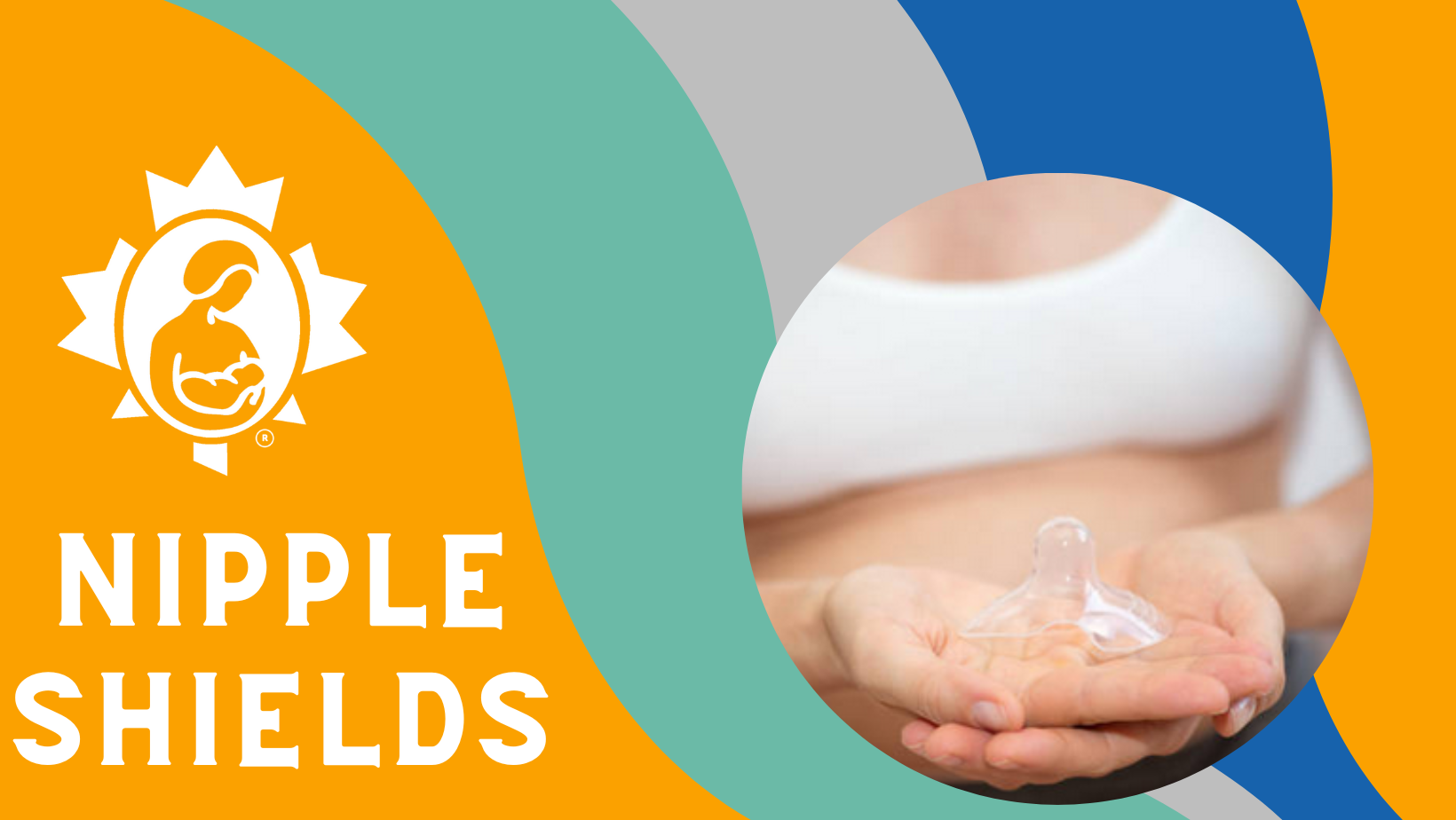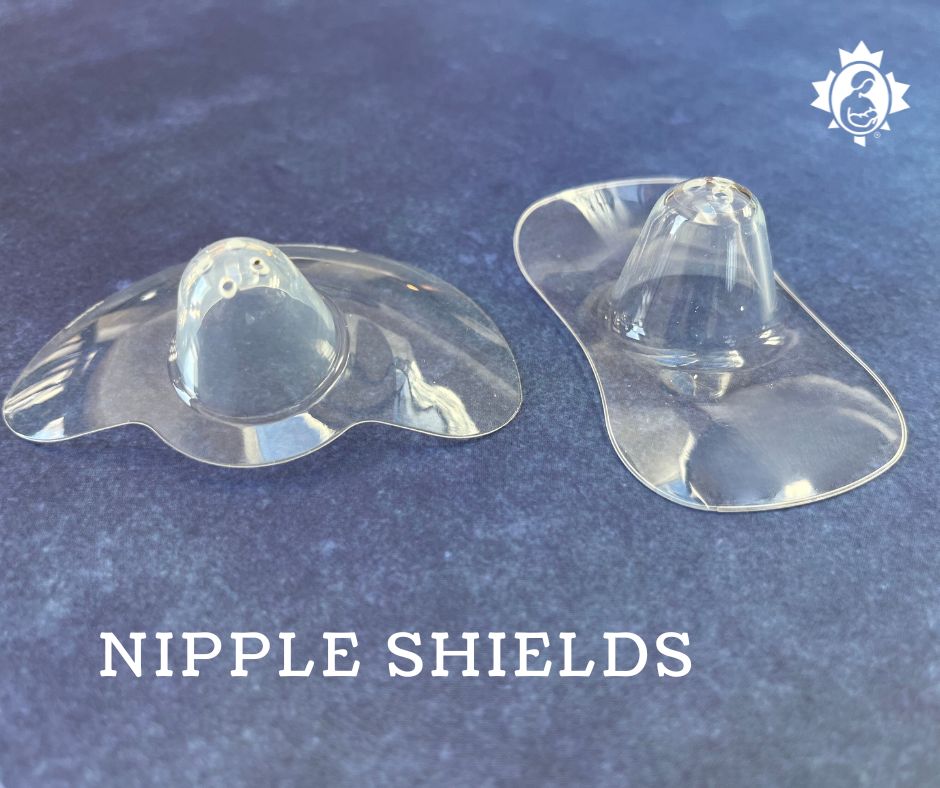
A nipple shield is a flexible, silicone nipple that looks like a hat with a large brim. It is placed over your own nipple during feedings. In some situations, it can be a short-term solution to help a baby who is having difficulty latching. Nipple shields are most helpful for premature babies. They can also help a baby latch to flat or inverted nipples. The firmness of the nipple shield makes it easier for the baby to latch and stay attached. If your baby has been using a bottle and is refusing to latch onto your breast, a nipple shield may help your baby transition back to feeding at the breast.

The Importance of Positioning and Latching
If a nipple shield is recommended, it’s important that your baby has a deep latch. This means that your baby's lips will be uncurled and on the brim of the shield, not just on the nipple. If your baby’s nose is touching the shield, angle your baby's head back slightly by pressing in gently between baby’s shoulder blades. The chin will now have better contact with the shield. With a good latch, your baby will be able to get plenty of milk. If your baby has a poor latch with the nipple shield, your nipples may hurt less, but your baby will not be able to remove milk effectively. This will lead to low milk production and poor weight gain.
The most common cause of sore nipples is a poor latch. A nipple shield is not an answer to this problem. What is helpful are better positioning and latching techniques. With a deeper latch, breastfeeding won’t hurt and your baby will get more milk. See Positioning and Latching.
Consult an IBCLC
If a nipple shield is recommended, or you think it might be helpful, consult with an International Board Certified Lactation Consultant (IBCLC) first. This healthcare professional will evaluate the need for a shield. There may be other strategies to resolve problems such as a poor latch, sore nipples, low milk production, etc. Contacting an LLL Leader can also help you decide what to do.
There are several different types of nipple shields. They all have slightly different shapes. The best brand is the one that fits your nipple comfortably and allows your baby to remove milk effectively. Nipple shields with at least one cut out contact area may stay on better and allow your baby to get more milk. To choose the correct size, the IBCLC will measure the diameter of the base of your nipple. The shield opening should be slightly wider than this measurement. The IBCLC will ensure the proper use of the nipple shield and confirm that your baby is drinking effectively at the breast with it in place.
Disadvantages of Using a Nipple Shield
- Your baby may not be able to remove milk effectively. This is common if your baby is not deeply attached.
- You are at increased risk of mastitis if milk is not removed well.
- Your baby may get used to the nipple shield and later refuse to latch onto your breast.
- It may be difficult to keep the shield in place while latching. This can be frustrating to both you and your baby. It can make nursing in public difficult.
- Nipple shields can get lost, misplaced, or damaged (by the dog!). You’ll likely need more than one.
- The shield needs to be cleaned regularly.
How to Apply and Care for a Nipple Shield
Nipple shields should be washed daily in hot soapy water and rinsed. Let them air dry. When applying the nipple shield:
- use your fingers to press into the tip of the shield so that the tip inverts slightly.
- stretch the shield slightly and place it over your nipple.
- sometimes moistening the shield slightly will help.
- allow your nipple to be drawn into the shield as you release your fingers.
- line up the contact area (cut out) so that your baby’s chin touches your bare breast. If your baby’s nose touches the shield, press in gently between your baby’s shoulders so that your baby’s head tips back and her nose moves away from the shield.
How to know your baby is getting enough milk when using a nipple shield
Look for the following signs:
- Adequate wet and poopy diapers.
- Regular deep swallowing.
- Softer breasts after feeding.
- Baby gaining weight.
- Baby content after feeding.
- No mastitis or hard areas after feeding.
If you have concerns about your baby’s weight, get regular weight checks. See How to Know Your Baby is Getting Enough Milk for more information.
How to Wean from a Nipple Shield
Before you attempt to eliminate the nipple shield, make sure that:
- you and your baby are positioned comfortably.
- you are able to achieve a good deep latch with the shield. See Positioning and Latching.
- your baby is using no bottles or only a few.
- you have adequate milk production. It can be very difficult to convince a baby to stay on the breast if there is little milk flow.
- you have lots of skin-to-skin time with your baby. See Skin-to-Skin for more information.
- Once you are ready to try feeding without a shield, here are some strategies that you can try: Express some milk before attempting to latch your baby. If your baby gets a mouthful of milk with the first suck, she’s more likely to continue sucking.
- Use a syringe, eye dropper or spoon to dribble milk down the breast so that your baby can latch and get an instant flow of milk.
- Offer the breast when your baby is interested but not too hungry.
- Try breastfeeding when your baby is slightly drowsy and not very aware. You may find it helpful to do this in the middle of the night or while walking or rocking.
- Start the feeding with the shield on. Once your milk starts to flow and your baby has been drinking steadily for several seconds, quickly remove the shield. Immediately latch your baby. Ideally, your baby will latch and continue drinking.
- Shape your breast by making a ‘sandwich’ between your thumb and forefingers. Shaping your breast can make it easier for your baby to latch. Make sure that your thumb and fingers are not too close to the nipple.
- Offer your breast before, during or after a feeding. Do what works best.
If your baby begins to fuss, quickly place the nipple shield on your nipple and allow your baby to feed as usual.
It is important to not frustrate your baby while you are trying to eliminate the nipple shield. If removing the shield becomes a battle between you and your baby, then it may become even more difficult to eliminate it. Continue to use one or more of the strategies above at as many feedings as you like. Most babies will eventually latch without the shield. Usually, it only takes a few successful feedings without the shield for your baby to no longer need it. It may take a few days or weeks. But most babies eventually are able to feed without the nipple shield.
You are breastfeeding your baby even if you need to temporarily use a nipple shield! Try not to let the task of removing the shield negatively affect your breastfeeding experience. The shield will likely disappear eventually. In the meantime, relax and enjoy nursing your baby.
If you have questions about using a nipple shield or any other breastfeeding questions, a La Leche League Leader can provide you with information and support.
If you have found this information sheet helpful, please consider making a donation.
